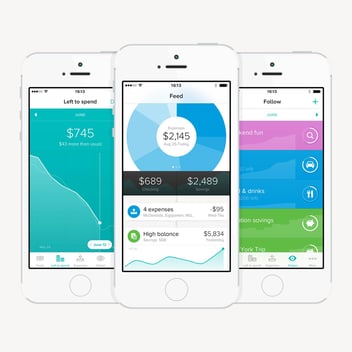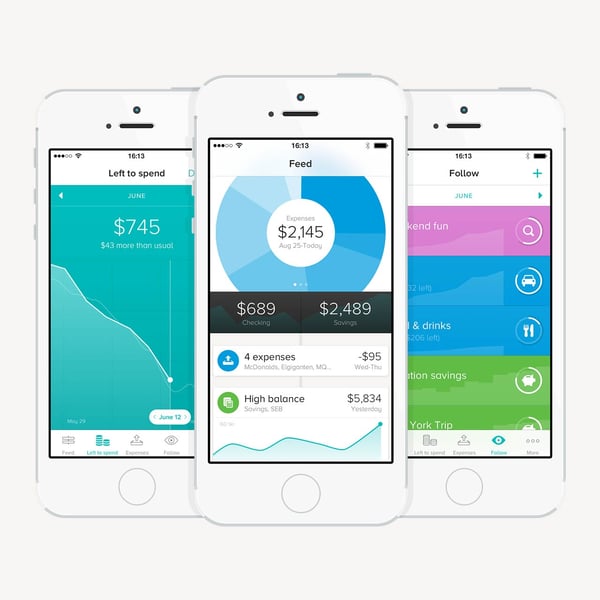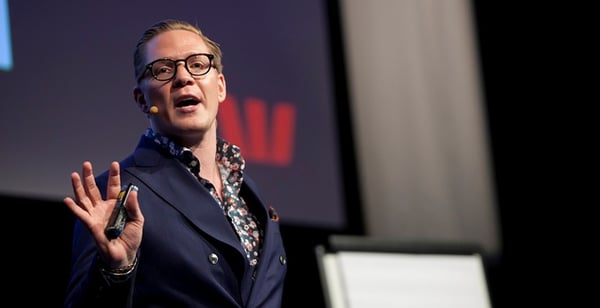Foresights and ideas that expand minds and inspire a change of heart.


In recent blogs I’ve discussed some of the disruptive changes that banking and finance have been going through over the last five years. I covered the cost of cyber criminals, and how banks need to be transformed by innovation rather than weighted down by regulation. As the banks move slowly towards change, we’ve seen financial technology companies like Lendico, TransferWise, FutureAdvisor and Tink revolutionise the ways consumers do their banking. Banking today has, thanks to digital technologies, become increasingly democratised and mobilised as the FinTech players decoupled consumers from their primary financial and banking relationship. In short, they’re enabling a more empowered future for adaptive futurephiles.
One of the startups in this space that fascinates me is the Swedish financial app Tink, founded in 2012 by Daniel Kjellén and Fredrik Hedberg. The Tink app now has over 400 000 users in Sweden (a country of not quite 10 million people) and the company has developed into Tink Technology, a B2B venture that powers some of Europe's largest banks.
The founders behind Tink had one simple idea: they wanted to help people gain a deeper understanding about their spending habits and thus educating them on how to be better at saving money. This was a challenging mission since many people find dealing with their personal finances a mundane and tedious – even stressful and difficult – task, and so avoid it. What the founders Kjellén and Hedberg decided to do to tackle this problem was to create a ‘gamefied interface’ and a user experience that made keeping track of your expenses, creating budgets and analysing your financial situation fun, easy and practical. The app is free and automatically connects with the user’s banks and services using the same kinds of security solutions as world-leading banks.

The key behind their success is the way that the app can visualise and automatically organise your money into different categories so that you as a user can track and compare your spending over time.
Many more traditional banks are now offering this type of monitoring as well, if in quite a broad-strokes kind of way. What’s clever about Tink is that the app also enables its users to set up savings targets and initiate payments and transfers, and allows you to identify which shopping habits you might need to change to be able to save those extra dollars that over time can build up to a significant amount. Enabling users to find these valuable insights by themselves provides a sense of pride, responsibility and, perhaps most importantly, a sense of control over their financial situation.
Tink makes managing personal finance a task that users can do spontaneously and on the go, without demanding too much of the user. It’s not surprising that the app has been so widely adopted in Sweden and internationally recognised by media outlets. Today’s consumers crave simplicity and want solutions like this that empower them to make smarter decisions.
This kind of user experience and interaction is very different from what people used to have with their bank manager or through a traditional banking app. It’s becoming increasingly clear that our relationships with banks are shifting – a recent Gallup study in the US showed 56 per cent of banking customers prefer a digital to a personal relationship with their bank. This is a development which start-ups such as Tink and Acorns have capitalised on. But, as the same Gallup study also showed, while customers want the convenience of multiple banking channels, 48 per cent of American banking customers would only consider using a bank that offered physical branches, with 75 per cent of customers having visited a branch in the last six months. In other words, customers want the best of the digital and analogue worlds – they want digilogue (a topic I’m so fond of I've written a book about it).

So, the interesting question here is how the battle between big banks and financial technology companies will play out in the next five or ten years. Will big banks manage to fight back with their new ‘customer-centric offerings’ while maintaining satisfying physical touch-points, or will new FinTech players continue to hold the edge?
Think about the following with regard to your business:

Header Text
Lorem ipsum dolor sit amet, consectetur adipiscing elit, sed do eiusmod tempor incididunt ut labore et dolore magna aliqua. Ut enim ad minim veniam, quis nostrud exercitation ullamco laboris nisi ut aliquip ex ea commodo consequat. Duis aute irure dolor in reprehenderit in voluptate velit esse cillum dolore eu fugiat nulla pariatur.
Lorem ipsum dolor sit amet, consectetur adipiscing elit, sed do eiusmod tempor incididunt ut labore et dolore magna aliqua. Ut enim ad minim veniam, quis nostrud exercitation ullamco laboris nisi ut aliquip ex ea commodo consequat. Duis aute irure dolor in reprehenderit in voluptate velit esse cillum dolore eu fugiat nulla pariatur.
Lorem ipsum dolor sit amet, consectetur adipiscing elit, sed do eiusmod tempor incididunt ut labore et dolore magna aliqua. Ut enim ad minim veniam, quis nostrud exercitation ullamco laboris nisi ut aliquip ex ea commodo consequat. Duis aute irure dolor in reprehenderit in voluptate velit esse cillum dolore eu fugiat nulla pariatur.

Header Text
Lorem ipsum dolor sit amet, consectetur adipiscing elit, sed do eiusmod tempor incididunt ut labore et dolore magna aliqua. Ut enim ad minim veniam, quis nostrud exercitation ullamco laboris nisi ut aliquip ex ea commodo consequat. Duis aute irure dolor in reprehenderit in voluptate velit esse cillum dolore eu fugiat nulla pariatur.
Lorem ipsum dolor sit amet, consectetur adipiscing elit, sed do eiusmod tempor incididunt ut labore et dolore magna aliqua. Ut enim ad minim veniam, quis nostrud exercitation ullamco laboris nisi ut aliquip ex ea commodo consequat. Duis aute irure dolor in reprehenderit in voluptate velit esse cillum dolore eu fugiat nulla pariatur.
Lorem ipsum dolor sit amet, consectetur adipiscing elit, sed do eiusmod tempor incididunt ut labore et dolore magna aliqua. Ut enim ad minim veniam, quis nostrud exercitation ullamco laboris nisi ut aliquip ex ea commodo consequat. Duis aute irure dolor in reprehenderit in voluptate velit esse cillum dolore eu fugiat nulla pariatur.

Header Text
Lorem ipsum dolor sit amet, consectetur adipiscing elit, sed do eiusmod tempor incididunt ut labore et dolore magna aliqua. Ut enim ad minim veniam, quis nostrud exercitation ullamco laboris nisi ut aliquip ex ea commodo consequat. Duis aute irure dolor in reprehenderit in voluptate velit esse cillum dolore eu fugiat nulla pariatur.
Lorem ipsum dolor sit amet, consectetur adipiscing elit, sed do eiusmod tempor incididunt ut labore et dolore magna aliqua. Ut enim ad minim veniam, quis nostrud exercitation ullamco laboris nisi ut aliquip ex ea commodo consequat. Duis aute irure dolor in reprehenderit in voluptate velit esse cillum dolore eu fugiat nulla pariatur.
Lorem ipsum dolor sit amet, consectetur adipiscing elit, sed do eiusmod tempor incididunt ut labore et dolore magna aliqua. Ut enim ad minim veniam, quis nostrud exercitation ullamco laboris nisi ut aliquip ex ea commodo consequat. Duis aute irure dolor in reprehenderit in voluptate velit esse cillum dolore eu fugiat nulla pariatur.
& STAY UP TO DATE WITH FORESIGHTS AND TREND REPORTS!
WE WILL EQUIP YOU WITH THE VIDEOS AND MATERIALS YOU NEED TO SUCCESSFULLY PITCH ASN.
0 Comment